Renaissance and the Catholic Church: A Historical Analysis Essay
VerifiedAdded on 2022/11/09
|5
|1094
|254
Essay
AI Summary
This essay examines the complex relationship between the Renaissance and the Catholic Church, focusing on the factors that led to the Reformation during the reign of Pope Leo X. It explores the societal and religious changes of the 16th century, highlighting the rise of Protestantism and the criticisms of the clergy. The essay analyzes the impact of the printing press, the translation of the Bible, and the corruption within the Church. Key figures such as Martin Luther, John Wycliffe, and John Huss are discussed, along with events like the Thirty Years War and Counter-Reformation. The essay argues that the Church's lavish extravagance, abuse of power, and resistance to reform contributed to its decline, paving the way for new religious ideologies and social structures.
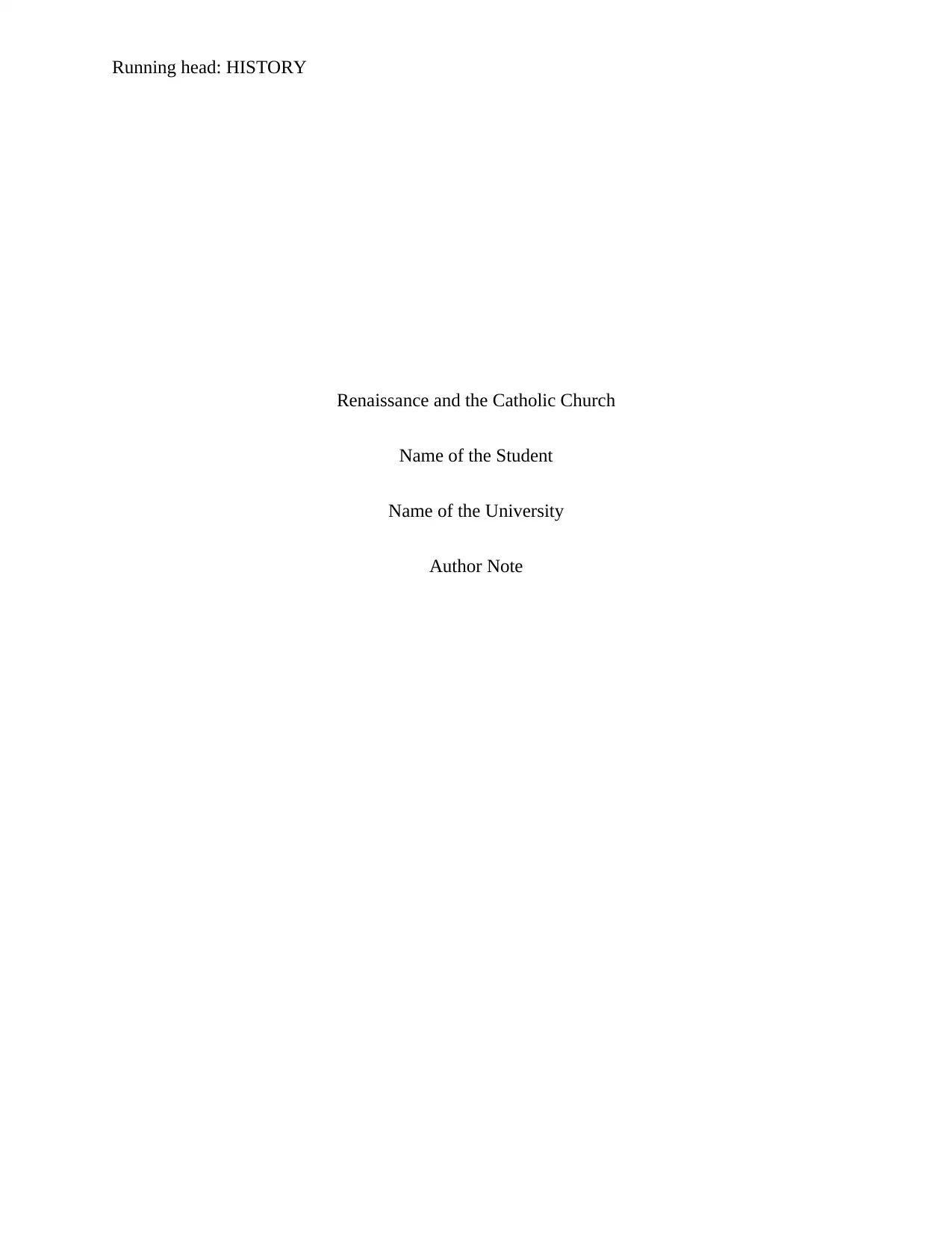
Running head: HISTORY
Renaissance and the Catholic Church
Name of the Student
Name of the University
Author Note
Renaissance and the Catholic Church
Name of the Student
Name of the University
Author Note
Paraphrase This Document
Need a fresh take? Get an instant paraphrase of this document with our AI Paraphraser
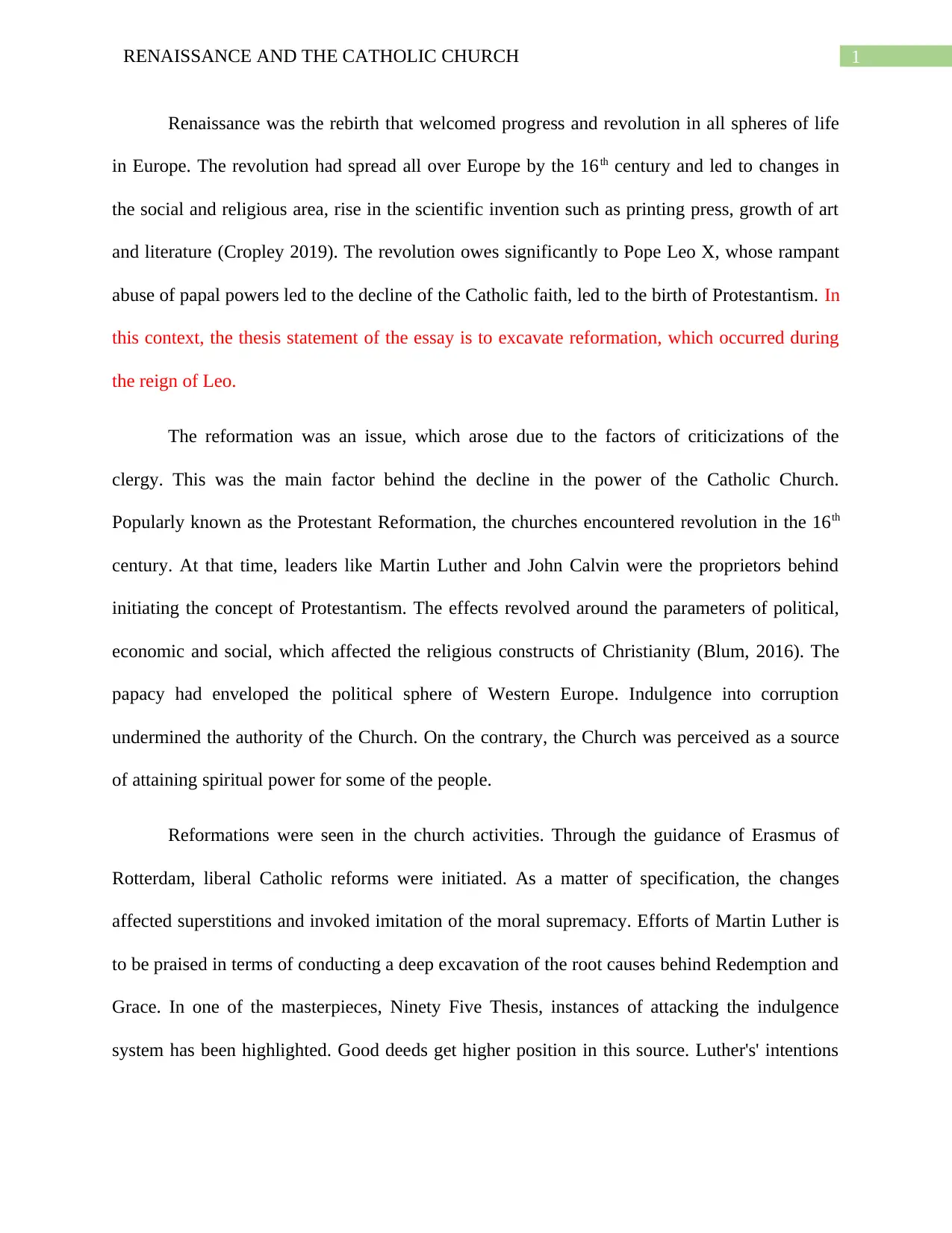
1RENAISSANCE AND THE CATHOLIC CHURCH
Renaissance was the rebirth that welcomed progress and revolution in all spheres of life
in Europe. The revolution had spread all over Europe by the 16th century and led to changes in
the social and religious area, rise in the scientific invention such as printing press, growth of art
and literature (Cropley 2019). The revolution owes significantly to Pope Leo X, whose rampant
abuse of papal powers led to the decline of the Catholic faith, led to the birth of Protestantism. In
this context, the thesis statement of the essay is to excavate reformation, which occurred during
the reign of Leo.
The reformation was an issue, which arose due to the factors of criticizations of the
clergy. This was the main factor behind the decline in the power of the Catholic Church.
Popularly known as the Protestant Reformation, the churches encountered revolution in the 16th
century. At that time, leaders like Martin Luther and John Calvin were the proprietors behind
initiating the concept of Protestantism. The effects revolved around the parameters of political,
economic and social, which affected the religious constructs of Christianity (Blum, 2016). The
papacy had enveloped the political sphere of Western Europe. Indulgence into corruption
undermined the authority of the Church. On the contrary, the Church was perceived as a source
of attaining spiritual power for some of the people.
Reformations were seen in the church activities. Through the guidance of Erasmus of
Rotterdam, liberal Catholic reforms were initiated. As a matter of specification, the changes
affected superstitions and invoked imitation of the moral supremacy. Efforts of Martin Luther is
to be praised in terms of conducting a deep excavation of the root causes behind Redemption and
Grace. In one of the masterpieces, Ninety Five Thesis, instances of attacking the indulgence
system has been highlighted. Good deeds get higher position in this source. Luther's' intentions
Renaissance was the rebirth that welcomed progress and revolution in all spheres of life
in Europe. The revolution had spread all over Europe by the 16th century and led to changes in
the social and religious area, rise in the scientific invention such as printing press, growth of art
and literature (Cropley 2019). The revolution owes significantly to Pope Leo X, whose rampant
abuse of papal powers led to the decline of the Catholic faith, led to the birth of Protestantism. In
this context, the thesis statement of the essay is to excavate reformation, which occurred during
the reign of Leo.
The reformation was an issue, which arose due to the factors of criticizations of the
clergy. This was the main factor behind the decline in the power of the Catholic Church.
Popularly known as the Protestant Reformation, the churches encountered revolution in the 16th
century. At that time, leaders like Martin Luther and John Calvin were the proprietors behind
initiating the concept of Protestantism. The effects revolved around the parameters of political,
economic and social, which affected the religious constructs of Christianity (Blum, 2016). The
papacy had enveloped the political sphere of Western Europe. Indulgence into corruption
undermined the authority of the Church. On the contrary, the Church was perceived as a source
of attaining spiritual power for some of the people.
Reformations were seen in the church activities. Through the guidance of Erasmus of
Rotterdam, liberal Catholic reforms were initiated. As a matter of specification, the changes
affected superstitions and invoked imitation of the moral supremacy. Efforts of Martin Luther is
to be praised in terms of conducting a deep excavation of the root causes behind Redemption and
Grace. In one of the masterpieces, Ninety Five Thesis, instances of attacking the indulgence
system has been highlighted. Good deeds get higher position in this source. Luther's' intentions
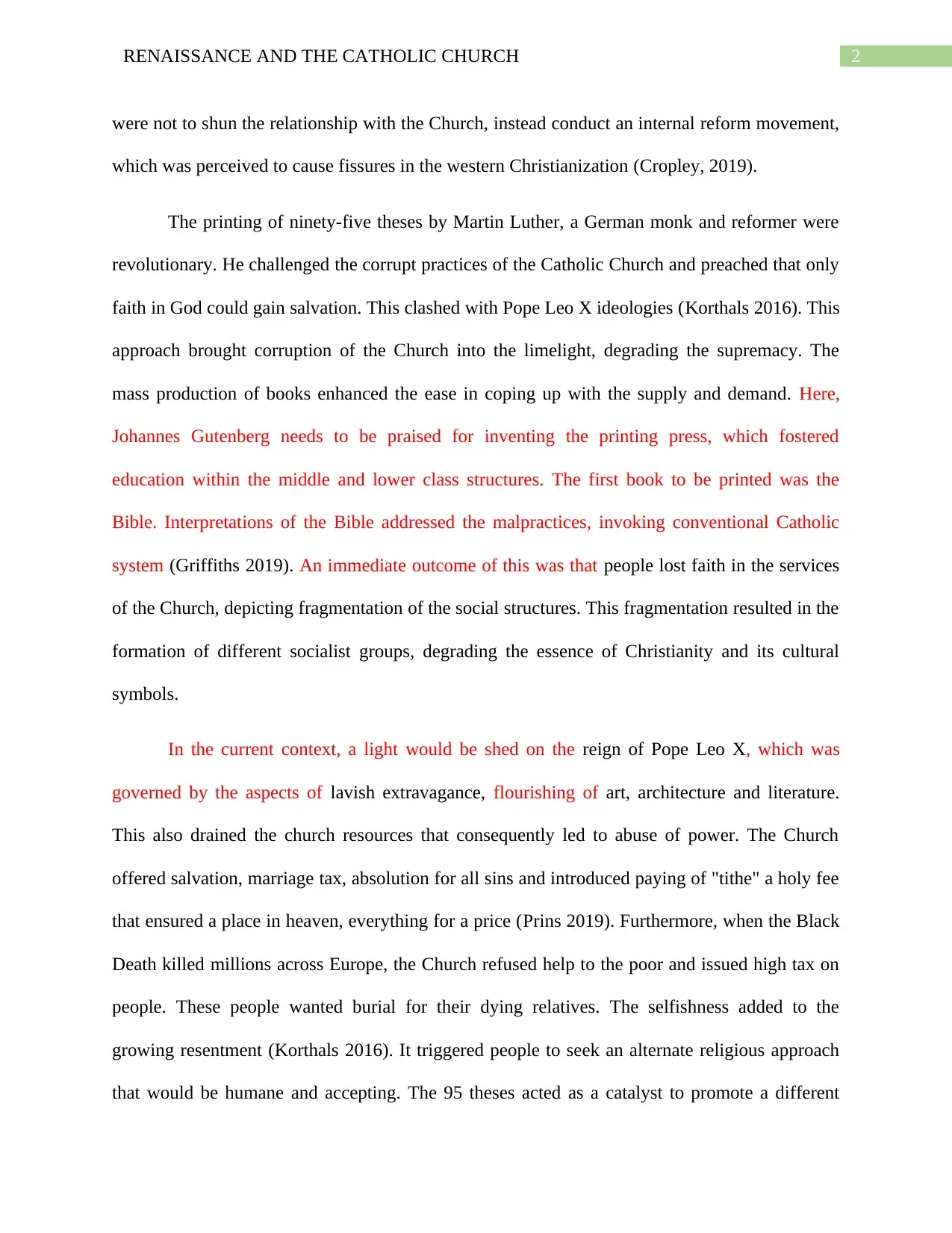
2RENAISSANCE AND THE CATHOLIC CHURCH
were not to shun the relationship with the Church, instead conduct an internal reform movement,
which was perceived to cause fissures in the western Christianization (Cropley, 2019).
The printing of ninety-five theses by Martin Luther, a German monk and reformer were
revolutionary. He challenged the corrupt practices of the Catholic Church and preached that only
faith in God could gain salvation. This clashed with Pope Leo X ideologies (Korthals 2016). This
approach brought corruption of the Church into the limelight, degrading the supremacy. The
mass production of books enhanced the ease in coping up with the supply and demand. Here,
Johannes Gutenberg needs to be praised for inventing the printing press, which fostered
education within the middle and lower class structures. The first book to be printed was the
Bible. Interpretations of the Bible addressed the malpractices, invoking conventional Catholic
system (Griffiths 2019). An immediate outcome of this was that people lost faith in the services
of the Church, depicting fragmentation of the social structures. This fragmentation resulted in the
formation of different socialist groups, degrading the essence of Christianity and its cultural
symbols.
In the current context, a light would be shed on the reign of Pope Leo X, which was
governed by the aspects of lavish extravagance, flourishing of art, architecture and literature.
This also drained the church resources that consequently led to abuse of power. The Church
offered salvation, marriage tax, absolution for all sins and introduced paying of "tithe" a holy fee
that ensured a place in heaven, everything for a price (Prins 2019). Furthermore, when the Black
Death killed millions across Europe, the Church refused help to the poor and issued high tax on
people. These people wanted burial for their dying relatives. The selfishness added to the
growing resentment (Korthals 2016). It triggered people to seek an alternate religious approach
that would be humane and accepting. The 95 theses acted as a catalyst to promote a different
were not to shun the relationship with the Church, instead conduct an internal reform movement,
which was perceived to cause fissures in the western Christianization (Cropley, 2019).
The printing of ninety-five theses by Martin Luther, a German monk and reformer were
revolutionary. He challenged the corrupt practices of the Catholic Church and preached that only
faith in God could gain salvation. This clashed with Pope Leo X ideologies (Korthals 2016). This
approach brought corruption of the Church into the limelight, degrading the supremacy. The
mass production of books enhanced the ease in coping up with the supply and demand. Here,
Johannes Gutenberg needs to be praised for inventing the printing press, which fostered
education within the middle and lower class structures. The first book to be printed was the
Bible. Interpretations of the Bible addressed the malpractices, invoking conventional Catholic
system (Griffiths 2019). An immediate outcome of this was that people lost faith in the services
of the Church, depicting fragmentation of the social structures. This fragmentation resulted in the
formation of different socialist groups, degrading the essence of Christianity and its cultural
symbols.
In the current context, a light would be shed on the reign of Pope Leo X, which was
governed by the aspects of lavish extravagance, flourishing of art, architecture and literature.
This also drained the church resources that consequently led to abuse of power. The Church
offered salvation, marriage tax, absolution for all sins and introduced paying of "tithe" a holy fee
that ensured a place in heaven, everything for a price (Prins 2019). Furthermore, when the Black
Death killed millions across Europe, the Church refused help to the poor and issued high tax on
people. These people wanted burial for their dying relatives. The selfishness added to the
growing resentment (Korthals 2016). It triggered people to seek an alternate religious approach
that would be humane and accepting. The 95 theses acted as a catalyst to promote a different
⊘ This is a preview!⊘
Do you want full access?
Subscribe today to unlock all pages.

Trusted by 1+ million students worldwide
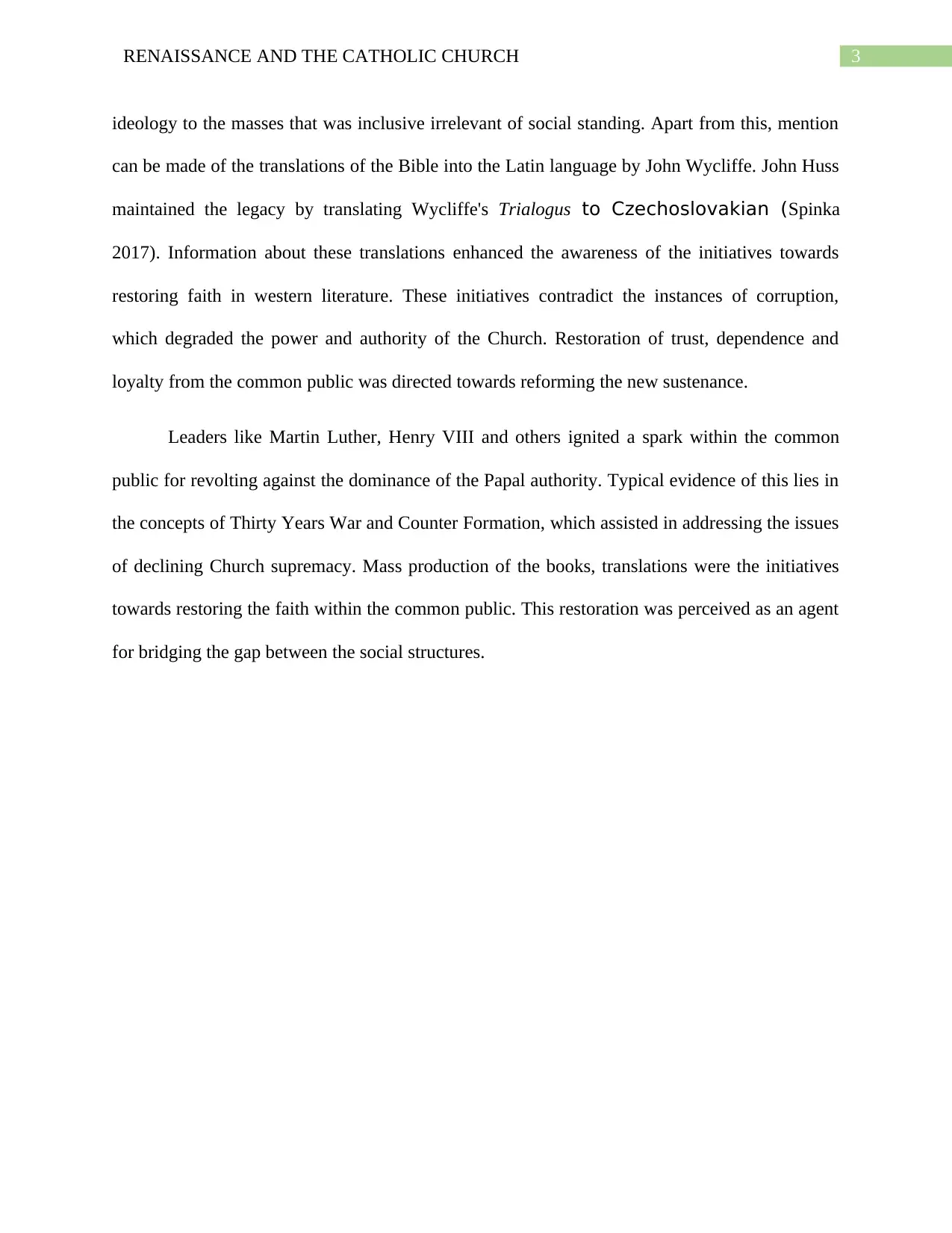
3RENAISSANCE AND THE CATHOLIC CHURCH
ideology to the masses that was inclusive irrelevant of social standing. Apart from this, mention
can be made of the translations of the Bible into the Latin language by John Wycliffe. John Huss
maintained the legacy by translating Wycliffe's Trialogus to Czechoslovakian (Spinka
2017). Information about these translations enhanced the awareness of the initiatives towards
restoring faith in western literature. These initiatives contradict the instances of corruption,
which degraded the power and authority of the Church. Restoration of trust, dependence and
loyalty from the common public was directed towards reforming the new sustenance.
Leaders like Martin Luther, Henry VIII and others ignited a spark within the common
public for revolting against the dominance of the Papal authority. Typical evidence of this lies in
the concepts of Thirty Years War and Counter Formation, which assisted in addressing the issues
of declining Church supremacy. Mass production of the books, translations were the initiatives
towards restoring the faith within the common public. This restoration was perceived as an agent
for bridging the gap between the social structures.
ideology to the masses that was inclusive irrelevant of social standing. Apart from this, mention
can be made of the translations of the Bible into the Latin language by John Wycliffe. John Huss
maintained the legacy by translating Wycliffe's Trialogus to Czechoslovakian (Spinka
2017). Information about these translations enhanced the awareness of the initiatives towards
restoring faith in western literature. These initiatives contradict the instances of corruption,
which degraded the power and authority of the Church. Restoration of trust, dependence and
loyalty from the common public was directed towards reforming the new sustenance.
Leaders like Martin Luther, Henry VIII and others ignited a spark within the common
public for revolting against the dominance of the Papal authority. Typical evidence of this lies in
the concepts of Thirty Years War and Counter Formation, which assisted in addressing the issues
of declining Church supremacy. Mass production of the books, translations were the initiatives
towards restoring the faith within the common public. This restoration was perceived as an agent
for bridging the gap between the social structures.
Paraphrase This Document
Need a fresh take? Get an instant paraphrase of this document with our AI Paraphraser
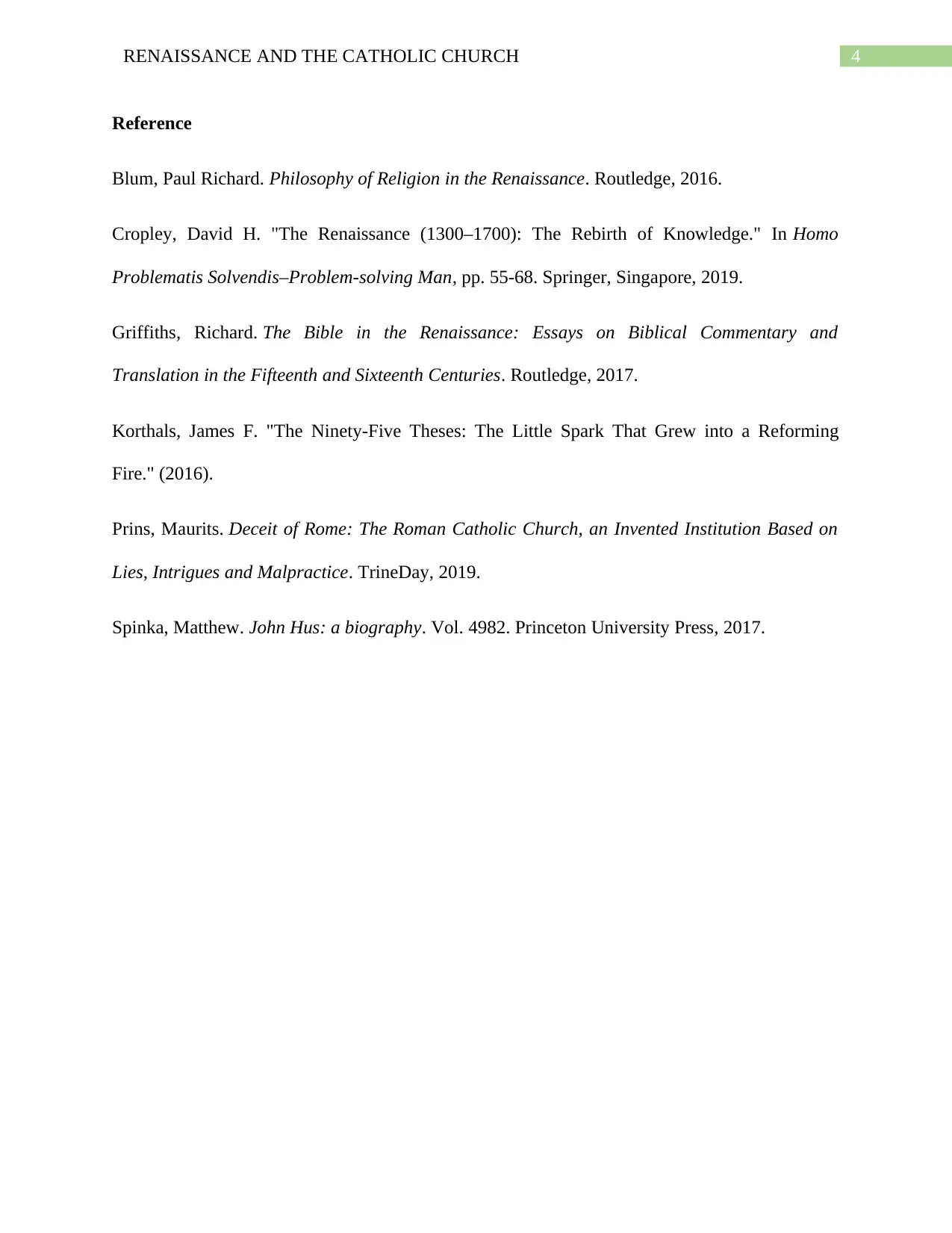
4RENAISSANCE AND THE CATHOLIC CHURCH
Reference
Blum, Paul Richard. Philosophy of Religion in the Renaissance. Routledge, 2016.
Cropley, David H. "The Renaissance (1300–1700): The Rebirth of Knowledge." In Homo
Problematis Solvendis–Problem-solving Man, pp. 55-68. Springer, Singapore, 2019.
Griffiths, Richard. The Bible in the Renaissance: Essays on Biblical Commentary and
Translation in the Fifteenth and Sixteenth Centuries. Routledge, 2017.
Korthals, James F. "The Ninety-Five Theses: The Little Spark That Grew into a Reforming
Fire." (2016).
Prins, Maurits. Deceit of Rome: The Roman Catholic Church, an Invented Institution Based on
Lies, Intrigues and Malpractice. TrineDay, 2019.
Spinka, Matthew. John Hus: a biography. Vol. 4982. Princeton University Press, 2017.
Reference
Blum, Paul Richard. Philosophy of Religion in the Renaissance. Routledge, 2016.
Cropley, David H. "The Renaissance (1300–1700): The Rebirth of Knowledge." In Homo
Problematis Solvendis–Problem-solving Man, pp. 55-68. Springer, Singapore, 2019.
Griffiths, Richard. The Bible in the Renaissance: Essays on Biblical Commentary and
Translation in the Fifteenth and Sixteenth Centuries. Routledge, 2017.
Korthals, James F. "The Ninety-Five Theses: The Little Spark That Grew into a Reforming
Fire." (2016).
Prins, Maurits. Deceit of Rome: The Roman Catholic Church, an Invented Institution Based on
Lies, Intrigues and Malpractice. TrineDay, 2019.
Spinka, Matthew. John Hus: a biography. Vol. 4982. Princeton University Press, 2017.
1 out of 5
Your All-in-One AI-Powered Toolkit for Academic Success.
+13062052269
info@desklib.com
Available 24*7 on WhatsApp / Email
![[object Object]](/_next/static/media/star-bottom.7253800d.svg)
Unlock your academic potential
Copyright © 2020–2025 A2Z Services. All Rights Reserved. Developed and managed by ZUCOL.

